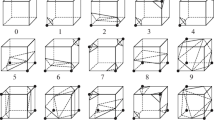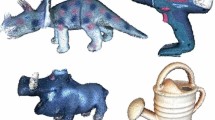Abstract
This paper proposes a novel technique to speed up the registration of 2D images to 3D models. This problem often arises in the process of digitalization of real objects, because pictures are often taken independently from the 3D geometry. Although there are a number of methods for solving the problem of registration automatically, they all need some further assumptions, so in the most general case the process still requires the user to provide some information about how the image corresponds to geometry, for example providing point-to-point correspondences. We propose a method based on a graph representation where the nodes represent the 2D photos and the 3D object, and arcs encode correspondences, which are either image–to–geometry or image–to–image point pairs. This graph is used to infer new correspondences from the ones specified by the user and from successful alignment of single images and to factually encode the state of the registration process. After each action performed by the user, our system explores the states space to find the shortest path from the current state to a state where all the images are aligned, i.e. a final state and, therefore, guides the user in the selection of further alignment actions for a faster completion of the job. Experiments on empirical data are reported to show the effectiveness of the system in reducing the user workload considerably.
Similar content being viewed by others
References
Bernardini, F., Rushmeier, H.E.: The 3D Model Acquisition Pipeline. Computer Graphics Forum 21(2), 149–172 (2002)
Callieri, M., Cignoni, P., Ganovelli, F., Impoco, G., Montani, C., Pingi, P., Ponchio, F., Scopigno, R.: Visualization and 3d data processing in David restoration. IEEE Computer Graphics & Applications 24(2), 16–21 (2004)
Callieri, M., Cignoni, P., Scopigno, R.: Reconstructing textured meshes from multiple range rgb maps. In: 7th Int.l Fall Workshop on Vision, Modeling, and Visualization 2002, pp. 419–426. IOS Press, Erlangen (D) (2002)
Corporation, I.: Open source computer vision library. URL http://www.intel.com/research/mrl/research/opencv/ (2001)
Dornaika, F., Garcia, C.: Robust camera calibration using 2d to 3d feature correspondences. In: Proceedings of the International Symposium SPIE – Optical Science Engineering and Instrumentation, Videometrics V, Volume 3174, pp. 123–133 (1997)
Faugeras, O., Toscani, G.: The calibration problem for stereo. In: Proceedings CVPR ’86, Miami Beach, Florida, pp. 15–20 (1986)
Goesele, M.: New acquisition techniques for real objects and light sources in computer graphics. Ph.D. Thesis, Universität Saarbrücken (2004). URL http://scidok.sulb.uni-saarland.de/volltexte/2004/338/
Lensch, H., Heidrich, W., Seidel, H.: Automated texture registration and stitching for real world models. In: Proc. 8th Pacific Graphics 2000 Conf. on Computer Graphics and Application, pp. 317–327. IEEE, Los Alamitos, CA (2000)
Lensch, H., Kautz, J., Goesele, M., Heidrich, W., Seidel, H.P.: Image-based reconstruction of spatial appearance and geometric detail. ACM Transaction on Graphics 22(2), 234–257 (2003). URL http://visinfo.zib.de/EVlib/Show?EVL-2003-10
Lowe, D.: Fitting parameterized three-dimensional models to images. IEEE Transactions on Pattern Analysis and Machine Intelligence PAMI-13(5), 441–450 (1991)
Matsushita, K., Kaneko, T.: Efficient and handy texture mapping on 3D surfaces. In: P. Brunet, R. Scopigno (eds.) Computer Graphics Forum (Eurographics ’99), Vol. 18(3), pp. 349–358. Blackwell Publishers (1999)
Neugebauer, P., Klein, K.: Texturing 3d models of real worls objects from multiple unregistered photographic views. Computer Graphics Forum (Eurographics’99 Proc.) 18(3), 245–255 (1999)
Pulli, K., Cohen, M., Duchamp, T., Hoppe, H., Shapiro, L., Stuetzle, W.: View-based rendering: Visualizing real objects from scanned range and color data. In: J. Dorsey, P. Slusallek (eds.) Eurographics Rendering Workshop 1997, pp. 23–34. Springer Wien (1997). ISBN 3-211-83001-4
Russell, S., Norvig, P.: Artificial Intelligence a Modern Approach. AI. Prentice_Hall (1995)
Sato, Y., Wheeler, M., Ikeuchi, K.: Object shape and reflectance modeling from observation. In: T. Whitted (ed.) Comp. Graph. Proc., Annual Conf. Series (SIGGRAPH 97), pp. 379–388. ACM SIGGRAPH (1997)
Tsai, R.: A versatile camera calibration technique for high accuracy 3D machine vision metrology using off-the-shelf TV cameras and lenses. IEEE Journal of Robotics and Automation RA-3(4) (1987)
Winkler, S., Wunsch, P., Hirzinger, G.: A feature map approach to real-time 3-D object pose estimation from single 2-D perspective views. In: Proc. 19th DAGM Symposium (Braunschweig, Germany, September 15–17), pp. 129–136 (1997)
Zhang, Z.: A flexible new technique for camera calibration (1998). URL http://citeseer.ist.psu.edu/316762.html; http://www.research.microsoft.com/∼zhang/Papers/TR98-71.pdf
Author information
Authors and Affiliations
Corresponding author
Rights and permissions
About this article
Cite this article
Franken, T., Dellepiane, M., Ganovelli, F. et al. Minimizing user intervention in registering 2D images to 3D models. Visual Comput 21, 619–628 (2005). https://doi.org/10.1007/s00371-005-0309-z
Published:
Issue Date:
DOI: https://doi.org/10.1007/s00371-005-0309-z




